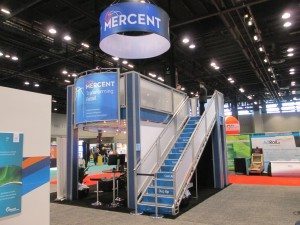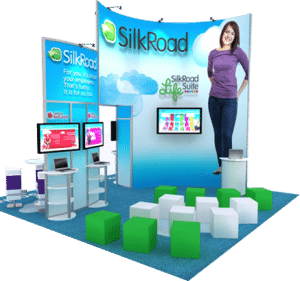Tune your Trade Show Booth to Actually Communicate with your Leads
You probably want to fine tune your trade show booth – everyone else does! We all want our exhibit, and more importantly, our company, to be remembered long after the show is over. But most of us are lucky to be remembered for as long as it takes to get to the snack bar.
How do you carve out a niche for yourself and turn your display booth into a marketing experience, rather than merely another booth with another bunch of graphics?
One creative and effective way is to engage as many senses as possible. Research has shown that people learn and remember in different ways, and they’re categorized as visual, auditory and kinesthetic learners. That means different people assimilate information best by what they hear, some by what they see and some by what they can touch.
The visual types are the ones most exhibitors focus their efforts on, with signage and graphics and literature that can be seen and read. But the other two types will also be at every show you attend, and two thirds of your prospects will miss out on what you have to say if you don’t meet them where they live and communicate in ways that get through their filters to become heard, understood and remembered.
Let’s review all three learning types, and see what you can do as an exhibitor to modify your trade show booth marketing strategy and be sure you get your message across to the different types of prospects:
Visual Learners:
As I mentioned, this is the type most exhibitors throw all their tools at, putting everything in writing and posting lots of pictures or images on the walls of their displays. But you can fine-tune your trade show booth to affect how you appeal to these types with a couple of steps.
1) Cancel clutter.
Visual learners need to scan the area they’re in and pick up visual cues that resonate with them. So clutter interferes with this process. Keep your exhibit sparse and inviting. That table that show organizers place in every booth is a wall that cuts you off from not just visual learners, but all types. So get rid of it, or place it lengthwise along one side of your exhibit, if you need it.
2) Turn your graphics into billboards.
Billboards—at least the effective ones—incorporate appealing colors with limited amounts of text and a single photo or illustration. After all, they’re meant to be read at 55 miles an hour. Visitors at a trade show are in a hurry, as well, and they want to take in as much information as they can, filter it and decide what deserves greater attention. They do this in nanoseconds, and you’ve got the length of an eye blink to capture their attention and convince them that what you offer has value to them.
Don’t create shopping lists of text that announce every product you sell or every feature of the products. Decide what you need to say in the shortest amount of space and time, tune your trade show booth and hone your message to fit. Save the lengthy descriptions for product literature that prospects can take with them or download once they’re back in the office.
Another tip: highlight the most important things you want passersby to read with strategically placed lighting.
Auditory Learners:
These people absorb information they hear much better than what they read. Research suggests that about 17% of the population is dyslexic, and have trouble taking in the written word. That’s almost one out of every five visitors to your booth! Using audio in your booth can be problematic, but here are some suggestions.
1) Speak to them.
Incorporate a video monitor into your exhibit, with interviews of people who use your product or service. Their testimonials will be especially appealing to auditory individuals, who take in information much easier this way. If necessary, subtitle your video so that its message still communicates, even in a noisy exhibit hall.
2) Present yourself well.
If you’re using a live presentation, make sure your presenter(s) can be heard. One way to do this effectively is to place the speakers at the rear of the audience area, facing toward the presenter. This covers everyone in your exhibit without blaring your presentation into your neighbor’s booth (which gets old fast and causes problems).
Kinesthetic Learners:
These people literally absorb information through their fingertips. In order for them to “get” what you’re trying to tell them, they need to be hands on somehow. The online media directory, FinderBinder, offers this suggestion: “Even if you cannot let visitors participate in demonstrations, you can encourage them to touch, lift, move, hear, see or dismantle your devices. Humans have five senses. The more of these you involve, the more visitors will remember about your exhibit.”
1) Please touch.
Don’t just show pictures of your product: show your product. Put your products on display in a way that visitors to your booth can actually handle them. Or show a model of the unique part(s) of your product that makes it better than the competition’s. Better yet, place that model where viewers can look at—and touch—it. If they can get their hands on it, they’ll get their minds around it.
2) Go interactive.
Can you create anything that makes learning about your product more sensory-involving? Take advantage of the available interactive trade show marketing tools that are on the market these days. An interactive game, survey or qualifying process will appeal to kinesthetic learners. They are literally seeking “touch points” to connect with your product or service, and it’s up to you to figure out how to give them what they need.
Finally, keep looking for ways you can tune your trade show booth and make your marketing message more sensory-rich. Beyond providing techniques for prospects to see, hear and touch your product or service, and understand its features and benefits, challenge yourself to appeal to as many senses as you can.
Some exhibitors do this by serving cookies, coffee, popcorn or ice cream in their booths. There are some hurdles to overcome to get permission to do this (check with show management for details), but it’s often worth the hassle to know that the wafting smell of freshly baking chocolate chip cookies is drawing prospects to your exhibit like the Pied Piper!
Don’t overlook how the design of your trade show booth can contribute to appealing to your prospect’s senses. The look and feel of your exhibit can serve to engage or put off would-be customers. If what you’re using now isn’t grabbing the attention of passersby, let’s talk about how we can help you design a new booth that pleases the senses while pleasing your management. Call us at (425) 556-9511 or email [email protected].
For more, check out how to get “that guy” to leave your booth or read how to sell solutions in your booth.


